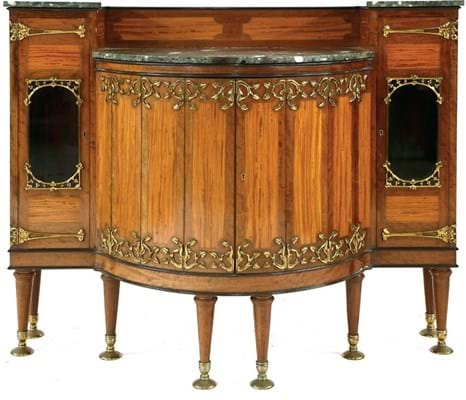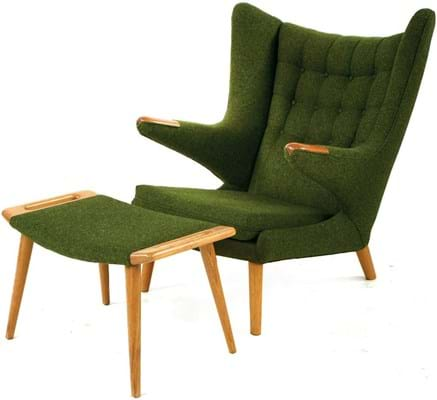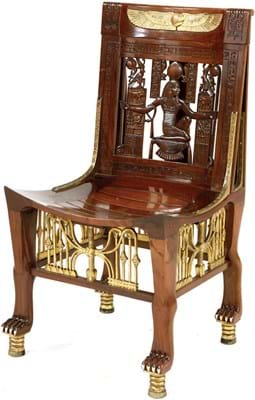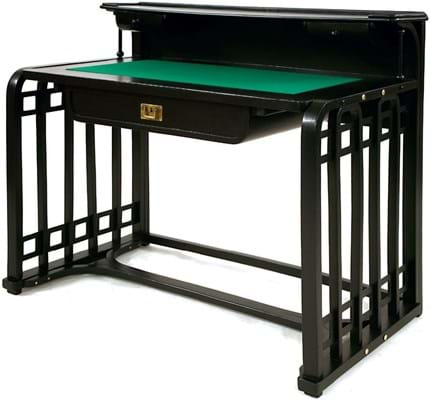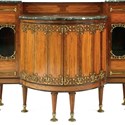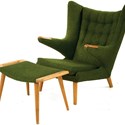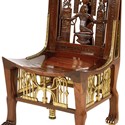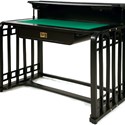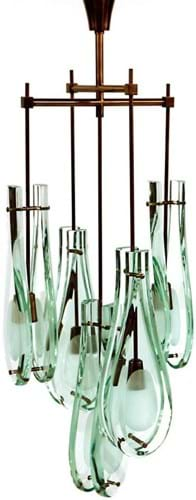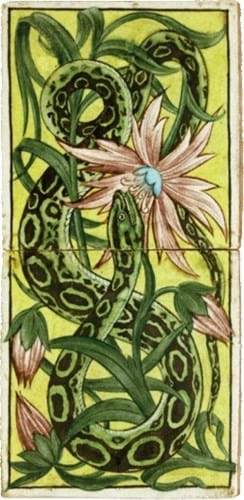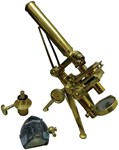William Arthur Smith Benson (1854-1924) was not just a designer and manufacturer of brass and copper lighting and other household objects.
As demonstrated by the rare veneered mahogany and satinwood cabinet side cabinet on offer at Sworders’ (23% buyer’s premium) Decorative Art and Design sale in Stansted Mountfitchet on January 29, he was also a designer of furniture.
Benson produced furniture designs for a number of renowned Victorian firms but is best known for his relationship with Morris & Co, where he became chairman after the death of William Morris in 1896.
Due to the high cost of production, relatively few pieces are known and this cabinet is one of the few to have appeared on the market. It sold at £10,000, the lower end of expectations, to a Continental buyer.
These Essex sales – running under the tutelage of specialist John Black for almost a decade – provide a complete cross-section of late 19th and 20th century design from Aestheticism to Scandinavian Modernism.
Another early offering was an ebonised desk designed by Josef Hoffman in 1905 for Vienna manufacturer Jacob & Josef Kohn and bearing the design number 500/6. The 3ft 7in (1.09m) wide desk had undergone some work but will need more professional restoration when the London-based Austrian bidder who took it at a mid-estimate £6600 sends it back home.
Among the most eye-catching pieces was the hardwood chair c.1925 to cater for the Egyptomania which swept Europe after Tutankhamun’s tomb was discovered in 1922.
Modelled after the 18th Dynasty chair found in the tomb, it sold to a Cambridge academic couple a shade below estimate at £9800. It had cost the vendor more than twice as much.
Pieces from the later 20th century, which Sunday newspaper supplements suggest are so on trend, were dominated by Italian and Scandinavian designs, many of which had long production runs.
Among them was a pair of rosewood Colonial chairs with lattice cane and leather seats designed by the influential Dane Ole Wanscher in 1949 for Poul Jeppeson. With labels featuring the PJ roundel and Danish Makers Control, the pair more than doubled the top estimate in selling to the London trade at £6500.
Going further above estimate was a set of four Scandia chrome, rosewood and laminate dining chairs designed by Norwegian Hans Brattrud for Hove Modler in 1957. Dating from the 1960s and pitched at £300-500, the set sold to the West Country trade at £1350.
Designed by Wegner in 1951, the Papa Bear chair and ottoman was produced by both PP Mobler and AP Stolen, who made the example at Sworders. Dating from the 1960s and recently reupholstered, it was estimated at £300-5000 and sold at £5600.
Italian rejuvenation
Many of the most popular names in the Italian field have their roots in the post-war era when Italy, rebuilding under conditions of scarcity, found its economic footing through manufacturing and progressive design.
The work of the architect and designer Paolo Buffa, who launched his oeuvre at the 1948 Salon des Artistes Decorateurs in Paris, often blends the traditional and the modern. His vellum and fruitwood side cabinet with satin legs over nine drawers and splayed legs proved popular at £1850.
Angelo Lelli established Arredoluce in Monza in 1947 while Ignazio Gardella founded the Azucena Agency the same year. A pair of classic Azucena brass table lamps with opaline glass shades sold at £780 while Lelli’s desk lamp with an hinged enamelled shade sold for £680.
Among the most eagerly contested lots in the sale was a glass five-light ceiling light in the style of French glass worker and decorator Max Ingrand, who worked for Fontana Arte from the mid 1950s. It made a multiple of its estimate at £4500.
“It went to a collector of Fontana who knew his subject, but the belief was that it was a copy, albeit a very good one,” said Black.
Prime-period Robert ‘Mouseman’ Thompson oak furniture is excelling at auction. Building on the success of the landmark sale of the Horlicks collection at Sworders last October, this sale included an unusual oak settle that, by family tradition, had been made by the Kilburn workshop for Ampleforth College.
Supplying furniture and architectural decorations to the school was Thompson’s most important early commission and was the place where he hit upon his now famous trademark.
This 6ft (1.83m) settle, with solid seat and scrolled arms, probably dating from the late 1920s or early ‘30s, was a private buy at £7100.
Also from the 1930s, a Mouseman wardrobe with a carved frieze and a pair of cupboard doors opening on iron batwing hinges sold at £4900, while a sideboard incorporating drawers and cupboards took £5600.
Merton Abbey De Morgan
Prices remain strong for William De Morgan tiles. A pair of 8in (21cm) square tiles with snake and flower design were from De Morgan’s Merton Abbey period (1882-88). Auctioneer John Black was hoping for a bit more than the £1500-2000 estimate but was “blown away” when they went to a collector at £6500.
Nearly 80% of the 730 lots got away to a hammer total of £333,000.
“There was a broad range of buyers, trade and private,” said Black. “Some were younger bidders, others were people in their 50s or 60s buying for their homes and then, of course, there were the interior decorators who simply want a look and are as happy with a £100 item as they are with more costly pieces.”


